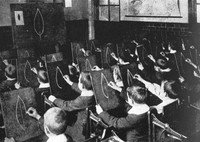
Schools as Factories - Part 1
We often use metaphors as a convenient way to communicate quickly without thinking very hard about what they really mean. However, the metaphors we use form our perceptions and guide our behavior in ways that we may not even realize. Consider the common metaphor that schools are like factories. The perception that education is a form of production harkens back to the industrial revolution when public schools copied the structures and practices dedicated to efficiency and production. We can still see traces of factory life in many of today’s schools:
• The belief that knowledge resides in experts (teachers) who transmit it to novices (students).
• Fixed rows of desks arranged to receive information from a single source (teacher).
• An emphasis on following directions rather than on problem-solving.
• The use of testing and grading of performance for quality control.
• The steady progression of students through the system in age “batches.”
• A bell driven daily schedule organized around rest breaks.
• The maintenance of uniformity through government policies, standards tests, curriculum documents, and support materials.
However, the factory metaphor has simply not kept pace with changes in society, our knowledge about how the brain works, or our increasing understanding about the effects of learning environments. Recently, Fred Gage, a neurobiologist at the Salk Institute in California, made this observation, “Changes in the environment change the brain, and therefore they change our behavior.”1
Although it was long supposed that human brains and capacities were fixed at birth, Gage and his colleagues have determined that new neurons are still being produced and that the capacity to add new memories and learn new skills can continue to grow throughout our lives. Furthermore, how fast these cells are added seems directly influenced by the richness of our interactions with our environment. This means that knowledge can no longer be seen as wholly teacher-driven or even confined to schools or to school hours.
Indeed, we more appropriately characterize learning today as a life-long interactive process in which meaning is socially constructed. The factory metaphor also fails to account for the shift in the epicenter of education from teachers to students. Students now have access to a vast online storehouse of information and have the capacity to produce and share data instantly with others around the globe.
Notes
1. Gage, F. (2003). Neuroscience and architecture. Paper presented at AIA 2003 National Convention and Expo. Retrieved July 20, 2014 from http://www.anfarch.org/wp-content/uploads/2013/11/2004-02-01-Fred-GageLecture-AIA-03-compressed.pdf


